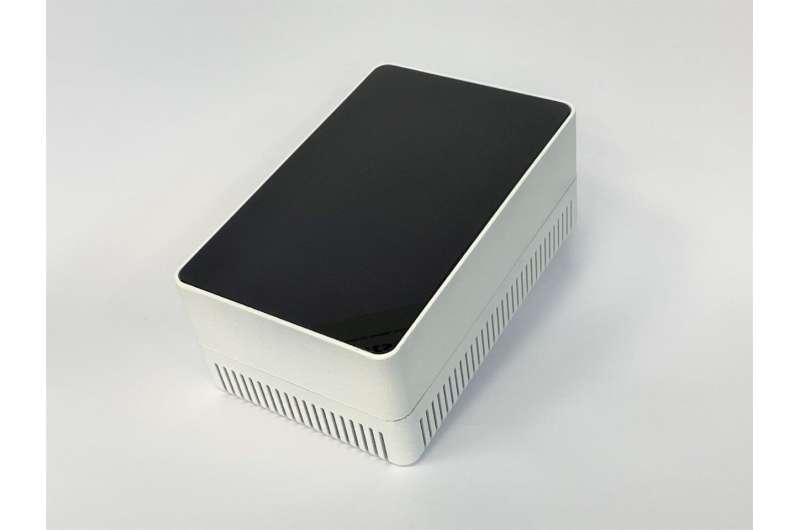This article has been reviewed according to Science X's editorial process and policies. Editors have highlighted the following attributes while ensuring the content's credibility:
fact-checked
trusted source
proofread
Fast, tap-proof data networks with light

The digital transformation means that more and more devices such as X-ray and ultrasound machines are being connected to networks in hospital settings, for example. These kinds of equipment have to be movable as needed.
In the LINCNET project, Fraunhofer researchers are using light to transmit data to machines and robots in clinical settings and industrial production environments. Combining electrical networks with the ultra-fast 5G mobile network creates powerful and low-cost wireless networks for buildings.
When deployed in hospitals, this solution means devices connect wirelessly to the network—with lower electromagnetic emissions. It also makes industrial production significantly more flexible.
Manufacturing in advanced Industry 4.0 scenarios is geared toward constant change. Order changes occurring on short notice require machines, robots, and measuring instruments to be rearranged quickly and incorporated into retooled production flows. The same applies to health care.
In both cases, conventional networks, in which machines and devices are connected via Wi-Fi, are not always optimal. In production settings, the various wireless networks can interfere with each other in unforeseeable ways. And in sensitive environments like hospital operating rooms, electromagnetic emissions from these networks are also an issue, as strict limits apply there. On top of that, there are data security risks. While the data traffic is encrypted, the wireless network itself remains fundamentally open to potential attackers.
Researchers from the Fraunhofer Institute for Telecommunications, Heinrich-Hertz-Institut, HHI in Berlin are working with project partners on a promising solution: data transmission via light. In the LINCNET (LiFi-enabled 5G for INdustrial and MediCal NETworks) project, the Fraunhofer researchers are harnessing the possibility of transmitting data by modulating light pulses. Standard commercially available LEDs and photodiodes are used as a light source and receiver, respectively.
Powerline: Data fed via the electrical network
Numerous applications call for combining the ultra-fast 5G networks with data transmission via light. One promising approach is reuse of the existing electrical network (power line communication, or PLC) to bring the data to the ceiling in every room and wirelessly transmit it the last few meters there using light (LiFi). The light signals do not pass through walls. This reduces electromagnetic emissions and is more energy efficient. PLC eliminates the need for costly laying of additional cables for the network.
Aachen-based company devolo Solutions GmbH, the lead entity in the LINCNET consortium, is responsible for PLC development and optimization. A LiFi module converts the data from the electrical network into impulses modulating the light signals. The light is continuously modulated by making it brighter and darker. The LEDs transmit their data to end devices equipped with transceiver units. The signal changes take place 100 million times a second and are not perceived by the human eye.
LiFi has clear advantages over wireless transmission of data. The data transmission itself is extremely robust and powerful. Within local networks, it enables latency times of under 2 milliseconds and transmission rates of up to 1 gigabit per second.
Project manager Lennert Bober points out additional advantages: "Light doesn't penetrate through walls, so there's no way to eavesdrop on it. The data transmission is also not affected by other wireless networks or by machines that emit radiation that could interfere with it, and it doesn't affect them, either."
Since the data are only transmitted within the cone of light itself, it is possible to supply many different machines or devices with data all at once without the light signals interfering with each other.
Ceiling module converts data to light signals
The Fraunhofer HHI team is relying on its decades of expertise in harnessing light to transmit data. Fraunhofer HHI co-developed LiFi and is also active in standardizing this technology. For the LINCNET project, the researchers have developed a ceiling module with a digital signal processor (DSP).
It extracts the data from the flow of electricity and converts them into pulses for digital modulation of the light source. The LED transmits the data from the ceiling to the end device placed within the cone of light, which could be a robot in a manufacturing setting or an ultrasound unit in a medical center, for example.
The data is isolated inside the cone of light just as it would be inside a cable. "It's just as secure as a cable network and performs equally well—just without cables," Bober explains.
Light has another crucial advantage in industrial applications, too. The spectrum can be used in any way desired, as the regulations that apply to radio do not exist for light. "Industry players don't have to request permission to use a certain frequency or pay licensing fees," Bober adds.
Highly scalable LiFi networks
The researchers from Fraunhofer HHI are also already working to further improve LiFi networks as part of the project. While using PLC to connect LiFi to the electrical network, they are also developing a combination involving fast Ethernet-based networks. While backhaul connections for wireless access points via Ethernet are common, this relies on a centralized approach similar to that used in 5G mobile networks.
In this kind of fronthaul network, each LiFi ceiling module has an Ethernet connection to a central unit, which makes it possible to coordinate LiFi transmissions on a space-time granular basis, significantly enhancing performance. "Highly scalable Ethernet connections paired with LiFi are a wonderful combination for real-time control of robots or high-end scenarios in medicine," Bober says.
For companies and hospitals alike, LINCNET can provide a noticeable boost for further digitalization and promote technological sovereignty in Germany by building skills in optical wireless communication.





















